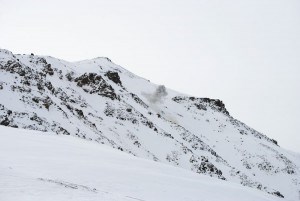
Using 26 kilograms of explosives—about four times what they usually use—Marmot Basin's avalanche technicians got just about everyone's attention during a controlled avalanche Jan. 16.
Reports indicate the blast could be heard as far away as Pyramid Lake, where people were enjoying a whole slew of winter activities as part of the opening weekend of Jasper in January.
The demonstration was held shortly after 1 p.m. in Outer Limits, a permanently closed area of the mountain that is visible from the top of the Canadian Rockies Express Quad Chair.
“In this environment, at the skill hill, our job is to protect the public from large avalanches that have the potential to injure or bury someone,” said Julie McBride, assistant director of public safety for Marmot.
“Depending on how much snow we have and what the conditions are we'll actually do avalanche control right on some of our main ski runs, which are steep and potentially have an avalanche hazard,” she said, adding that Marmot also does avalanche work in permanently closed areas where there is potential for an avalanche to run inbounds, such as the area above the Knob chairlift.
According to McBride, there are two ways to conduct a controlled avalanche, either using a hand charge or an “avalauncher,” similar to a massive potato gun that uses pressurized nitrogen to launch explosives into mountain slopes.
During the public demonstration, the team used a hand charge with a 2.5-minute fuse to ignite a primer that was set into a 25-kilogram sack of ANOF (ammonium nitrate/fuel oil).
To ensure the controlled avalanche would take place where they wanted it, the team lowered a metal saucer—with the explosives attached to it—down the edge of the slope with a rope.
“When we're doing avalanche control sometimes you'll want the avalanche right near the top of the slope or sometimes there will be more snow lower down so you'll need to lower the bomb down to it,” said McBride.
“It's precise like lawn darts. If you know the expression 'horseshoe and hand grenades,' this is essentially hand grenades,” she said.
So far this year the avalanche conditions at Marmot haven't been very bad, according to McBride.
“We got a lot of snow in November and we were very busy then trying to open our terrain, but since the first week of December we really haven't had any significant snowfall,” said McBride.
“What we have had though is really cold temperatures and what those cold temperatures do is rots out the snowpack from underneath so it makes the snow very weak.”
Because there hasn't been a lot of snow, she said the chance of actually getting buried by an avalanche right now is pretty low, but the chance of hitting rocks and other debris poses a serious risk.
“The big thing for us is asking people to respect our sign lines. If there is a sign and rope line there that says 'closed for avalanche danger', please stay out of there because not only are you putting yourself at risk, but if something were to potentially happen to you in there, rescuers would be potentially at risk as well.”
Paul Clarke
[email protected]
